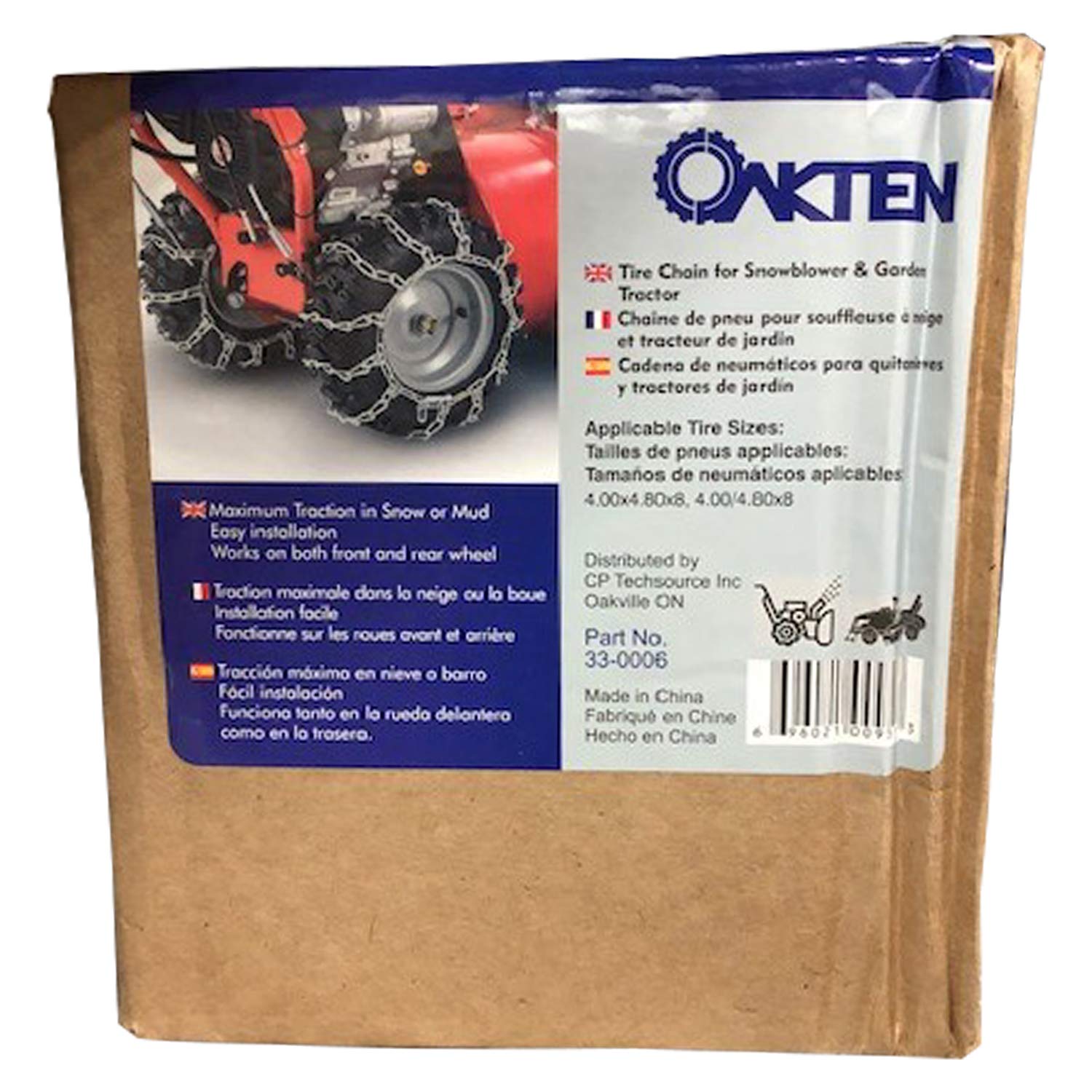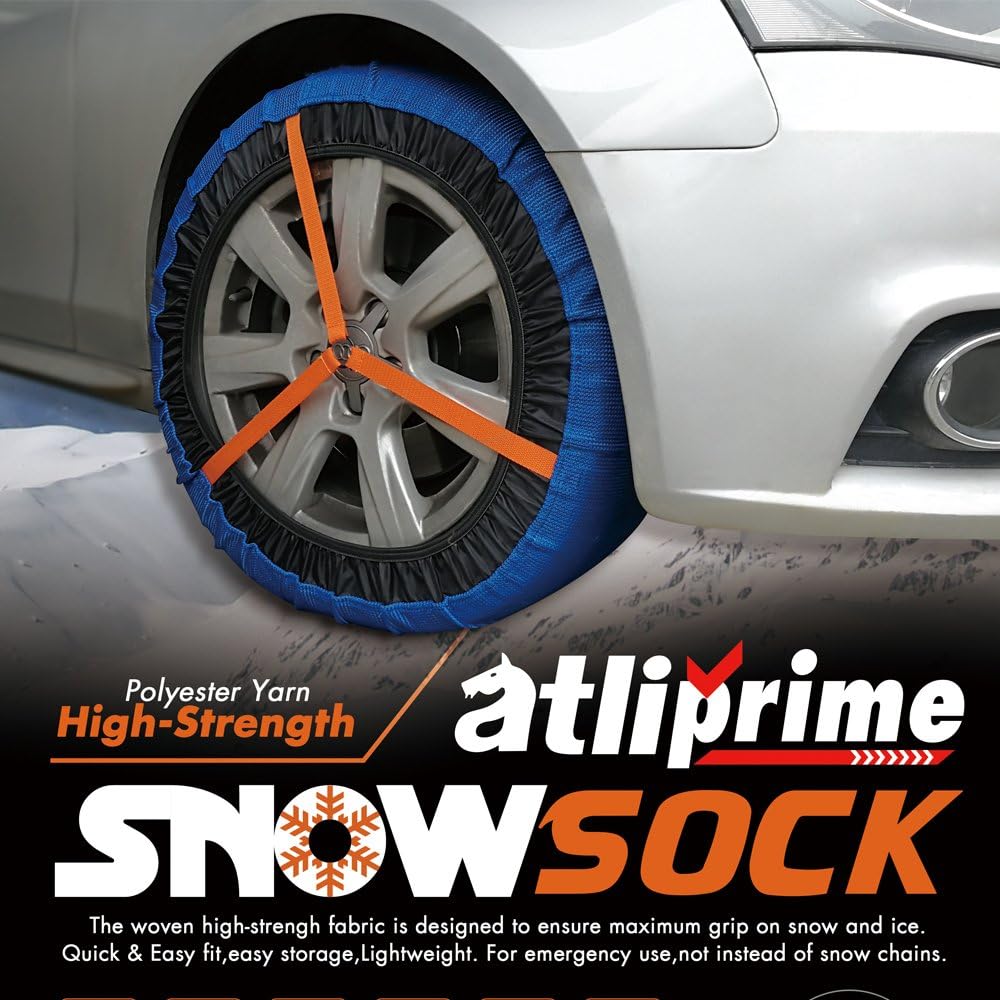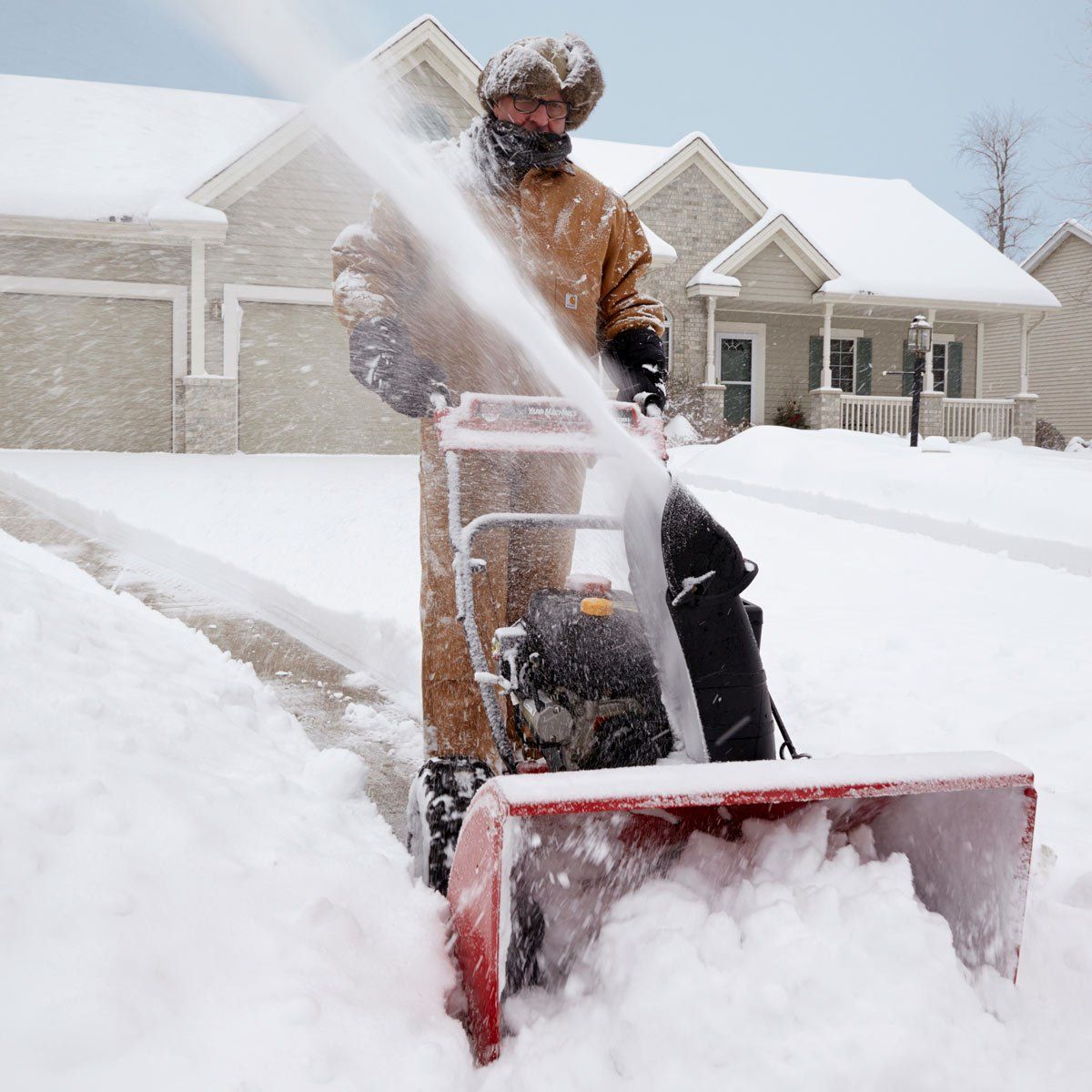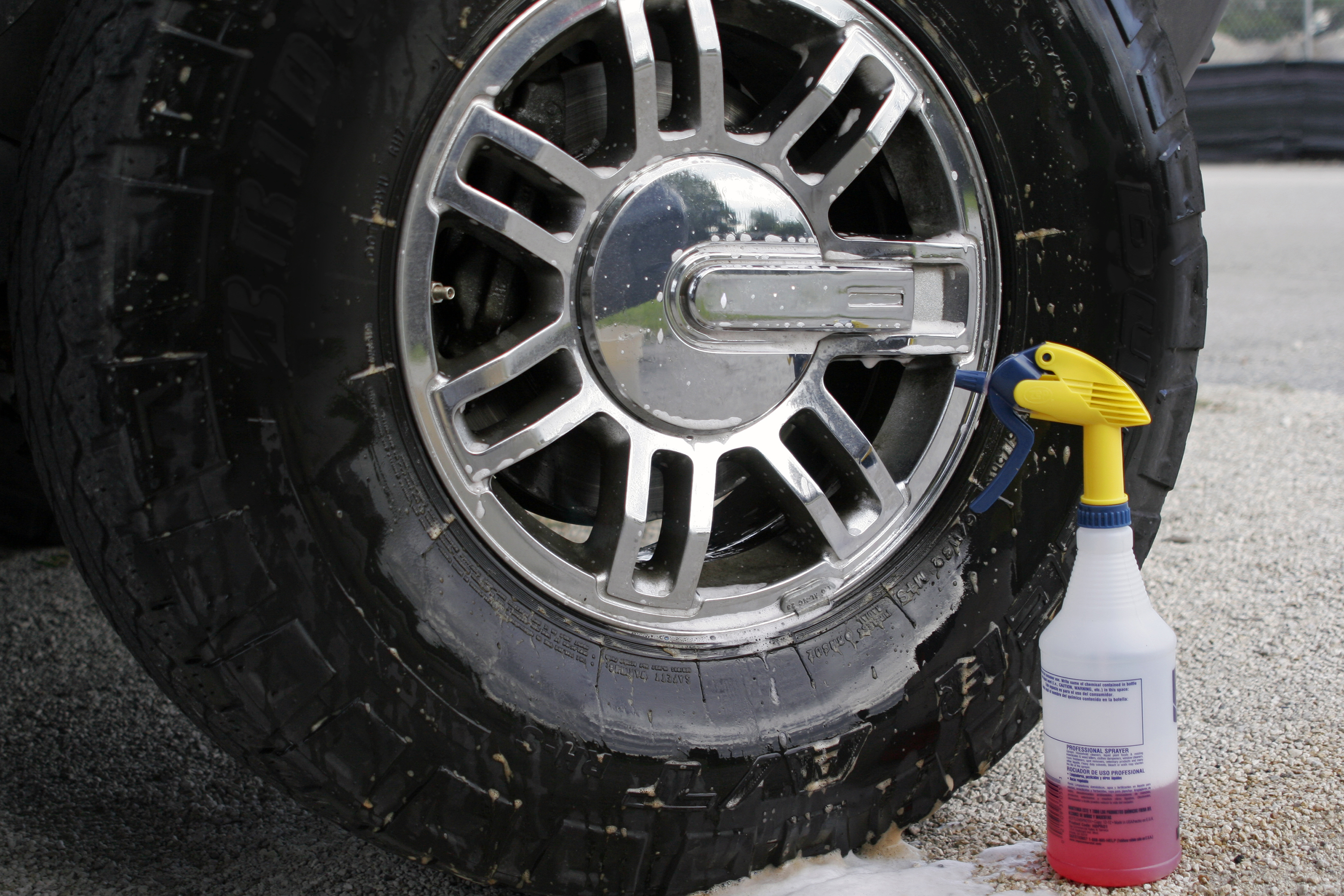Have a flat on your Honda snowblower? Just got it out of storage to find a tire has come off a rim? Here’s what you need to do to fix it and keep it from happening again.
All Honda snowblowers built in the past two decades that use pneumatic tires are tubeless. That means if you have a leak, it’s in the tire itself. It also means that if the tire separates from the rim, the bead needs to be reseated to reinflate the tire.
Tire pressure should be checked before each use, even if you got your snowblower out the day before. If the temperature drops 10°F, tire pressure can drop up to one PSI. Tires can also lose one PSI each month they’re in storage. Honda’s snowblower tires are designed to operate at 8.5 PSI, so it doesn’t take much for the pressure to drop significantly between uses.
Removing the wheel will make it much easier to work on the tire. Honda offers some tires and wheels as a complete set, letting you replace a bent rim and tire in one step.
1. Disconnect the spark plug wire to prevent an accidental start.
2. Lift up the rear of the snowblower so that the tires are off the ground.
3. Depending on the model, there will be either a bolt or a Clevis pin on the axle. Remove this part, and slide the wheel off of the axle.
4. Slide the new wheel onto the axle and tighten down the bolt or reinstall the pin.
5. Air up the tire before lowing the snowblower to keep the bead from separating it from the rim.
If the tire pressure is too low, rolling the snowblower can cause the tire bead to roll off of the rim. If that happens, it can be reseated by using air pressure to push out the sidewalls of the tire:
1. Remove the wheel.
2. Hold the tire and wheel in a way that lines the bead up with the rim.
3. Connect the air valve to a compressor or a pressurized air tank. You may need to go over the recommended operating pressure to push the bead onto the rim, but try not to go above the maximum pressure on the sidewall. The goal isn’t to put a lot of air in the tire, it’s to put the air in quickly to get the bead to meet with the rim.
You may need to go over the recommended operating pressure to push the bead onto the rim, but try not to go above the maximum pressure on the sidewall. The goal isn’t to put a lot of air in the tire, it’s to put the air in quickly to get the bead to meet with the rim.
Most of the time, the tire will expand and seat on the rim with just air pressure. If the bead still doesn’t want to seat, there are a few things you can try:
— Apply grease on the inside lip of the wheel. This helps the tire slide up to the rim, and can reduce the amount of air escaping as you air up the tire.
— Remove the valve stem. This reduces resistance when airing up the wheel. Be gentle handling the wheel and tire when reinstalling the stem as the lack of air pressure can let the bead slide off of the rim again.
— Tie a ratchet strap or a rope around the tire tread. This pressure will help push out the sidewall so the bead doesn’t have as far to go to meet with the rim. To tighten a rope, slide a piece of pipe between it and the tire and twist, wrapping the rope around the bar.
It is possible to spray the rim with starter fluid and light it to pull the tire onto the rim, but it should be obvious that this is extremely dangerous. If the tire is that difficult to fit, it’s worth getting a complete wheel and tire instead of setting your snowblower and yourself on fire.
If there are cracks in the rubber or damage to the tire, it should be replaced.
1. Remove the wheel from the snowblower.
2. Push in the tire valve to release any remaining air inside the tire.
3. Use a set of tire levers or spoons to pull the bead over the rim. Once one bead is off the wheel, lift up the tire and pull the other bead over.
4. Fit the new tire onto the wheel using the spoons or levers.
5. Use the process above for reseating the bead. Air up the tire to the correct pressure, then install the wheel on the snowblower.
www.hondalawnparts.com is a certified Honda Power Equipment dealer, so we’re able to ship any OEM part currently available to any address in the U. S. or Canada. Check out our wheels section to find a replacement for your snowblower, or use our search system to find the right part for your model.
S. or Canada. Check out our wheels section to find a replacement for your snowblower, or use our search system to find the right part for your model.
By Amy Rodriguez
Not everyone lives in a region that receives consistent yearly snowfall, but many areas are prone to cold winter weather that can produce a surprise snowy day. Snow blowers carefully stored for years will need to be dusted off and powered on. However, many owners will find that one of their snow blower tires will just not hold any air. In these cases, the tire needs to be replaced. Careful attention to the tire's attachment point will guide you to a successful snow blower repair.
Unscrew the gas cap from the snow blower. Lay a piece of plastic wrap across the open gas orifice. Carefully screw the gas cap back on. This plastic wrap will prevent any harmful fuel spills during tire replacement.
Choose a sturdy surface to work on the snow blower, such as within a garage or on a concrete driveway. Lay a tarp down to protect the surface from any damage from the auger blades or dropped tools.
Lay a tarp down to protect the surface from any damage from the auger blades or dropped tools.
Tilt the snow blower up onto its auger by pushing the handlebar forward. If the snow blower is too heavy for you to tilt, ask a friend to help with the pushing process.
Examine the snow blower's bad tire connection to the snow blower. Each manufacturer has a different attachment design to the axle. The connecting screw should be on the center of the exterior wheel assembly or behind the wheel on the axle rod.
Detach the connecting screw from the blower with a screwdriver or socket driver. Fasteners may differ between manufacturers; consult the blower's specific manual for particular fastener types. Slide any washers off of the connection point and place aside.
Slide the wheel and tire assembly off of the blower's axle. Place a new tire and wheel assembly onto the blower's axle.
Place any necessary washers onto the connection point. Insert the fastener onto the connection point and tighten with the screwdriver or socket driver. If your blower model has a screw torque specification, use a torque driver to tighten the fastener to the manufacturer's value listed in the owner's manual.
Insert the fastener onto the connection point and tighten with the screwdriver or socket driver. If your blower model has a screw torque specification, use a torque driver to tighten the fastener to the manufacturer's value listed in the owner's manual.
Tilt the snow blower back down into its normal ground position carefully. Remove the plastic wrap from the gas cap. Tighten the gas cap back down onto the snow blower.
Test the snow blower's new tire by rolling it across the garage or driveway. The movement should be smooth and bump-free.
References
Tips
Writer Bio
Writing professionally since 2010, Amy Rodriguez cultivates successful cacti, succulents, bulbs, carnivorous plants and orchids at home. With an electronics degree and more than 10 years of experience, she applies her love of gadgets to the gardening world as she continues her education through college classes and gardening activities.
With an electronics degree and more than 10 years of experience, she applies her love of gadgets to the gardening world as she continues her education through college classes and gardening activities.
Working on a tractor, one has to deal with punctures and cuts in the wheel, the most difficult to repair is the rear tires. If the tires are very worn out, it is better to replace them by choosing original branded models. Our catalog contains tires for wheeled excavators and tractors, from which you can choose the most optimal set. The page contains an assortment of regular models with information on sizes and other parameters.
Minor damage can be repaired by sealing the tire. To complete this task, you need to disassemble the wheel, and this is a very laborious work. However, if you have an assistant and experience, serious difficulties should not arise. In this article, we will give useful instructions, after reading which you can carry out repairs yourself.
Before proceeding with the repair, it is necessary to dismantle and remove the rubber from the disk. The most convenient way to do this is by hanging the rear axle of the tractor with a jack or using the hydraulic system. In the latter case, a massive stump or other base can be placed on one side at the back. To disassemble, you will need 2 crowbars, a sledgehammer, a massive chisel, instead of which you can use a blunt ax without a handle.
Step-by-step instructions for removing a tire:

The damage can be small or extensive, further repair depends on the degree of the defect:
On the inside, a patch is also glued over the entire area to prevent the camera from being rubbed.
As regards the latter situation, it is better to replace the tire with a new one in case of a three-dimensional cut. As practice shows, after deep and penetrating cuts, the rubber goes a little and still has to be changed.
If there is a puncture, repair with a patch is possible. It is better to buy a repair kit in a specialized store, it includes a patch and glue. The camera is removed, washed and dried, the puncture site is found and marked with a marker or pen. For this, a bath of water is suitable, into which the inflated chamber is lowered.
Repair is carried out with cleaning and degreasing of surfaces, the patch is placed under a small load for 15-20 minutes. Before installation, the camera is first placed in the tire and pumped up a little so that it straightens out.
Share
A snow blower is a complex piece of equipment that requires systematic maintenance and proper operation. It is important to use in accordance with the manufacturer's instructions. Otherwise, the frequency of breakdowns will inevitably increase, and with it the cost of repairs. However, simple repairs in case of urgent need can be done on their own. Next, we will talk about the common causes of malfunctioning snowplows and how to eliminate them.
Otherwise, the frequency of breakdowns will inevitably increase, and with it the cost of repairs. However, simple repairs in case of urgent need can be done on their own. Next, we will talk about the common causes of malfunctioning snowplows and how to eliminate them.

Finding out that this is the part that has failed can be determined by unsuccessful attempts to actuate the wheels or augers using buttons or levers. After all, it is one belt that transmits the torque to the auger, the second to the wheels. To replace the belts, loosen the cables, remove the cover that hides the belts, and unscrew the nuts securing the drive. Next, the old belt is removed and a new belt is put in. Since this breakdown is quite common, it is recommended that you immediately purchase an additional drive belt when buying a snow blower.
Soft metal auger fasteners are an important consumable item. They prevent serious damage to equipment in the event of a collision with an obstacle. When in contact with a stone, fence or curb, the keys are cut off, thereby stopping the operation of the augers. The temptation to replace soft screws with stronger ones is best avoided. Otherwise, saving on inexpensive keys will result in the need to purchase a new snow blower.
They prevent serious damage to equipment in the event of a collision with an obstacle. When in contact with a stone, fence or curb, the keys are cut off, thereby stopping the operation of the augers. The temptation to replace soft screws with stronger ones is best avoided. Otherwise, saving on inexpensive keys will result in the need to purchase a new snow blower.
The snow blower has a friction disc and wheel in close proximity. The disc is driven by the wheels, after which the friction wheel returns the momentum to the snowplow wheel. When slipping or a sharp start at high speed, the ring breaks, causing the steel wheel to deform the aluminum rim.
According to experts, many breakdowns are the result of improper operation and, to a lesser extent, maintenance and conservation of snowplows. In this regard, the owners of snow blowers are strongly recommended to carefully read the instructions for use, replace consumables in a timely manner, and store the device correctly in the summer.